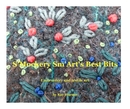While I was thinking about it, Gina Ferrari raised the perennial question about pricing on her blog Fan my Flame. I was interested to read the comments, many of which suggested that the price should reflect the size of the item and not the work that went into it. Her response was to explain the processes and costs involved in making her hand embroidered brooches here. This struck a chord with me, because some of my dolls are quite small and the processes involved in making them look the way that they do are not immediately obvious.
I had a real problem pricing that last witch doll, so I thought I would document the process involved in making this next one, that is slightly more elaborate. (This is Part 1, Parts 2 and 3 are below, I published in reverse order).
1.

(Click on photo for bigger image)
I started with an offcut of fleece fabric, a piece of recycled "eco-felt" and some scraps of silk. I layered the fleece over the felt, scattered silk scraps over and "mangled" it all together on the needlepunch (embellisher) machine.
2.

(Click on photo for bigger image)
Strands of coloured wool tops (roving); gossamer light and fine as a spider's web, mangled all over the top.

(Click on photo for bigger image)
The needlepunching gives a nice texture and a "felty" feel!
3.

(Click on photo for bigger image)
Rows of machine quilting in my favourite Greek Key stitch pattern, for even more texture and interest. I used grey in the bobbin and black in the needle, and loosened the bobbin tension for a slight "cable stitch" effect for a little more texture and interest. I wanted a worn and faded look for this piece of fabric.
That's the body fabric finished...






1 comment:
It's wonderful to offer this kind of information I think. Before I started making things myself, I had no real understanding of why handcrafted pieces were often so expensive. But it's easy to understand when you see all the work involved like this!
Post a Comment